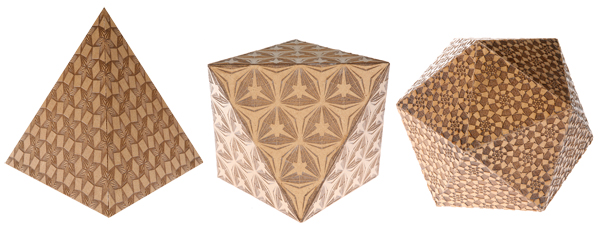Briony Thomas
Lecturer in Design Theory, School of Design, University of Leeds, UK
"After studying the geometry of repeating patterns as a student of textile design, I became interested in the possibilities of patterns repeating in three-dimensions, around the faces of mathematical solids. This interest led to an investigation into which of the 17 plane classes can regularly repeat around the Platonic solids. The successful application of a pattern to repeat across the faces of a polyhedron, is determined by the pattern's underlying lattice structure and its inherent symmetry operations. The project resulted in the creation of a collection of pattern designs and regularly patterned polyhedra, inspired by geometric tilings found at the Alhambra Palace in Granada, Spain."
“Polyhedra de los Leones ”
2007, Laser-etched wood composite, 56 cm x 20 cm x 20 cm
Polyhedra de los Leones features the tetrahedron patterned with p6m, the octahedron patterned with p3m1 and the icosahedron patterned with p6. These patterns are constructed on a hexagonal lattice, where the unit cell comprises two equilateral triangles. The rotational symmetries of the tetrahedron and icosahedron are maintained by pattern classes p6 and p6m due to the higher order of symmetry within the plane pattern. Centres of six-fold rotation, characteristic of the plane pattern, become axes of three-fold rotation at each vertex on the tetrahedron. Axes of two- and three-fold rotation are also preserved in the solid, with six reflection planes evident. Only pattern classes containing six-fold rotation are applicable to regularly patterning icosahedron. Centres of six-fold rotation in the pattern become axes of five-fold rotation at each vertex and all other rotational symmetries are preserved. The two units, created by each half of the pattern class p3m1 unit cell, permit repetition across the eight octahedral faces and result in two-fold rotation at each vertex. Although no rotation is present at the solid's edges, six planes of reflection are evident.